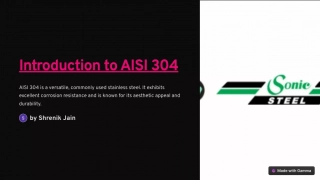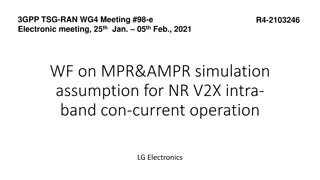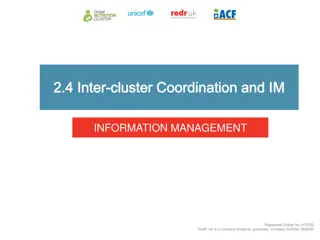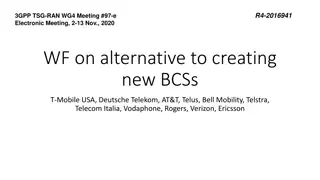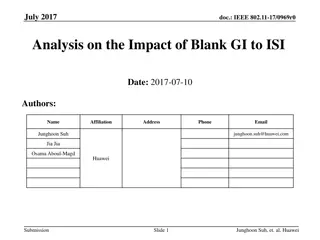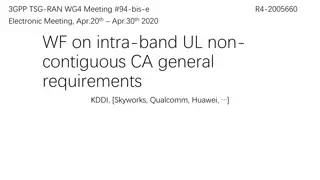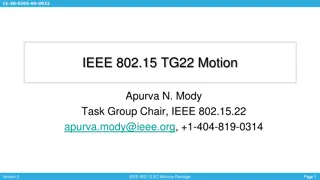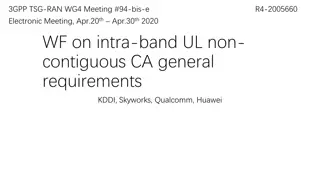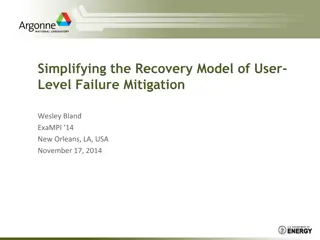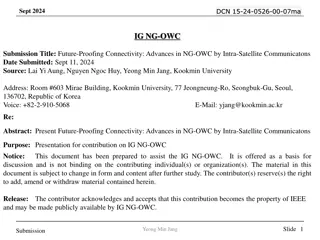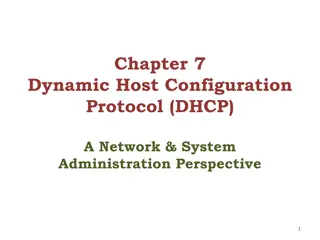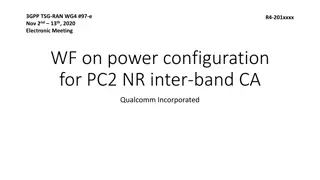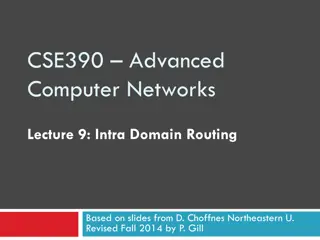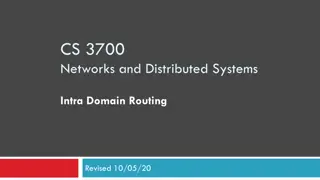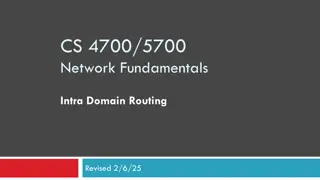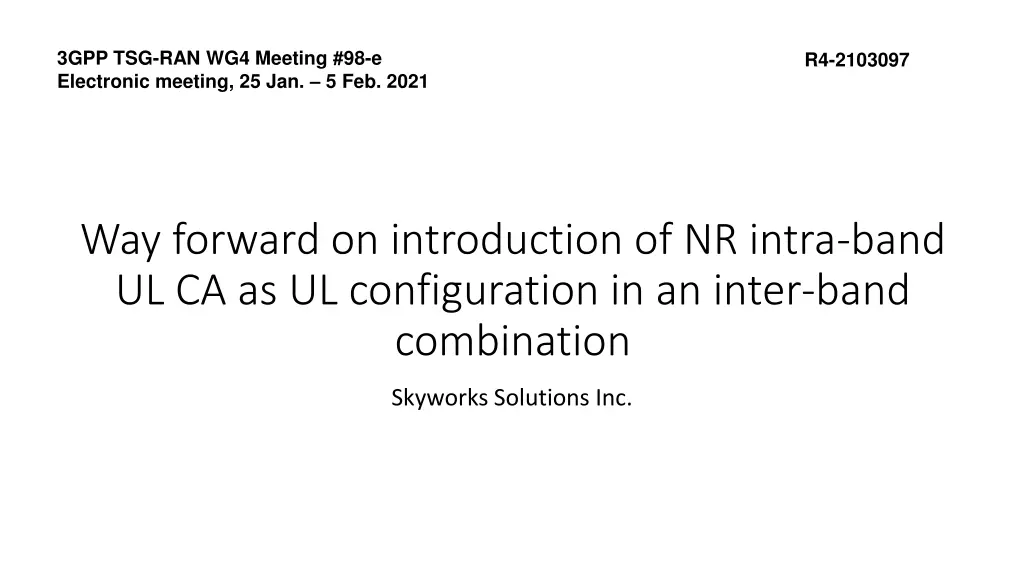
Introduction of NR Intra-Band UL Configuration in Inter-Band Combination
Explore the guidelines on introducing an UL configuration with NR intra-band UL CA in an inter-band setup. Understand the impact on MSD, band protections, and emissions, and potential requirements for RAN4. Discover the three types of intra-band UL CA cases and the generated IMD products. Dive into the background of UL CA types in inter-band combinations and the considerations for simultaneous TX/RX cases.
Download Presentation

Please find below an Image/Link to download the presentation.
The content on the website is provided AS IS for your information and personal use only. It may not be sold, licensed, or shared on other websites without obtaining consent from the author. If you encounter any issues during the download, it is possible that the publisher has removed the file from their server.
You are allowed to download the files provided on this website for personal or commercial use, subject to the condition that they are used lawfully. All files are the property of their respective owners.
The content on the website is provided AS IS for your information and personal use only. It may not be sold, licensed, or shared on other websites without obtaining consent from the author.
E N D
Presentation Transcript
3GPP TSG-RAN WG4 Meeting #98-e Electronic meeting, 25 Jan. 5 Feb. 2021 R4-2103097 Way forward on introduction of NR intra-band UL CA as UL configuration in an inter-band combination Skyworks Solutions Inc.
Scope Capture guidelines on how to introduce an UL configuration that contains an NR intra-band UL CA part in an inter-band: Inter-band NR CA, inter-band EN-DC and inter-band NR DC are in scope Unlike the introduction of an intra-band configuration in DL that can be introduced with a simple CR as it does not create new UL related MSD issue, the change of UL configuration may have impact on MSD and potentially to band protections and emissions The new MSD issues must be assessed to clarify if RAN4 need to introduce new requirements or put constraints on how these are introduced These guidelines will be used to evaluate potential revision of CRs that are introducing n7B UL CA configuration [1-4] for next meeting
Background on intra-band UL CA types in an inter- band combination: There are three types of intra-band UL CA cases that can be introduced in an inter- band combination: Type 1: The intra-band part is the only UL part, for example UL configurations like CA_nXB, CA_nXC, CA_nX(2A): 2 UL CC are involved Type 2: The intra-band part is part of an inter-band UL configuration, for example UL configurations like CA_nYA-nXB, CA_nYA-nXC, CA_nYA-nX(2A), DC_nYA_nXB, DC_nYA_nXC, DC_nYA_nX(2A), : 3 UL CC are involved but in some cases there are 3 separate sub-blocks Type 3: there is intra-band UL CA in both UL bands: 4 UL CCs are involved more triple beat tones are generated but it is an extension of type 2 and there could be up to 4 separate sub-blocks In all cases new IMD products are generated compared to the initial case: Two tone IMDs of the 1RB+1RB worst case allocation for type 1 Triple beat IMDs of the 1RB+1RB with the second band UL for type 2 Even more Triple beat IMDs of the 1RB+1RB in both bands for type 3 These issues exist only for simultaneous TX/RX case There has been no real discussion in RAN4 about these types of cases Potential MSD issues have not been assessed Are >2 separate sub-blocs valid?
Background: Illustration of issues for type 1 and type 2/3 cases DL CC3-1 UL CC2-1 UL CC2-2 DL CC1-1 Delta F Delta F Delta F Delta F Band 1 UL Band 1 DL IMD5 Band 2 w intra UL CA Band 3 DL IMD3 IMD3 IMD5 of the 1RB+1RB case from the UL CA configuration of band 2 fall in the DL of band 1 IMD3 of the 1RB+1RB case from the UL CA configuration of band 2 fall in the DL of band 1 => This issue can apply to two band or three band inter-band combinations Type 1 2 UL DL CC3-1 UL CC1-1 UL CC2-1 UL CC2-2 DL CC1-1 Delta F Delta F Delta F Delta F Delta F Band 1 UL Band 1 DL IMD5 + triple beat tone Band 2 w intra UL CA Band 3 DL IMD3 IMD3 Same IMD products than type 1 but with additional triple beat tones here FUL_CC1 + FUL_CC2-2 FUL_CC2-1 => This issue can be very severe if the UL intra-band distance between the two allocation is close to the duplex distance but also is it is equal to the distance between the single UL and another band This issue can apply to two band or three band inter-band combinations Type 3 has two time type 2 cases Type 2/3 3/4 UL
CA_1A-1A-7C CA_1A-3C CA_1A-1A-3C CA_1A-7C CA_1A-41C CA_1A-42C CA_2A-48C CA_3A-7C CA_3C-7A CA_3C-7C CA_3C-8A CA_3C-20A\_3C-28A\_3C-38A CA_3A-41C CA_3A-41D CA_3A-42C CA_3A-42A-42C\ _3A-42C-42C CA_4A-5B CA_4A-4A-5B CA_5A-5A-66A-66B\_5A-5A-66B CA_5A-66B\_5A-66A-66B CA_5B-66A CA_5B-66B CA_7C-28A CA_18C-41C CA_18A-41C CA_28A-42C CA_28A-42A/C-42C CA_39A-41C CA_39A-41D CA_39C-41A CA_39C-41C CA_41A-42C CA_41A-42A/C-42C\CA_41C-42A/C-42C CA_41C-42A CA_41C-42C CA_41C-48A/C/D\_41D-48A/C CA_46A/C-48C\_46A-48D/E\_46C-48D/E CA_46A/C/D/E-48B CA_7C CA_1A-3A\_3C CA_3C CA_1A-7A\_7C CA_1A-41A/C CA_1A-42A/C\_42C CA_2A-48A, CA_48C CA_3A-7A\_7C CA_3A-7A\_3C CA_3A-7A\_3C\_7C CA_3A-8A\_3C CA_3C CA_3A-41A/C\_41C CA_3A-41A\_41C CA_3A-42A/C\_42C CA_3A-42A\_42C CA_5B CA_4A-5A\_5B CA_5A-66A\_66B CA_66B CA_5B CA_5B\_66B CA_7A-28A\_7C CA_18C-41C CA_18A-41A/C CA_28A-42A\_42C CA_42C CA_41C\_39A-41A/C CA_41C\_39A-41A CA_39C\_39A/C-41A CA_39C\_41C\_39A-41A CA_41A-42A/C\_42C CA_42C CA_41A/C-42A\_41C CA_41A/C-42A/C\_41C\_42C CA_41C CA_48C CA_48B Background: current LTE cases UL configurations including intra-band UL CA 2 UL CC intra-band UL CA: class B 20MHz IMD5 OOB range, class C 40MHz OOB range => no cross band isolation issue 3UL CC intra-band UL CA + 1 UL: class B 20MHz TB range, class C 40MHz TB range => < duplex distance in most cases => no issue for FDD band de- sense 4UL CC intra-band + intra-band UL CA: 1 TDD-TDD case and > 700MHz distance no cross-band isolation issue In all cases no more than two contiguous sub-blocks In LTE there is only contiguous intra-band UL configurations within inter-band combinations => intra-band IMDs have limited spread beyond their band (40MHz IMD5 offset), and Intra-band CA maximum aggregation BW is small compared to FDD duplex distance. Given the above there is no need to check potential additional MSD when and intra-band UL part is added to an UL configuration for an inter-band combination
Background: current NR CA and ENDC cases Already in 38.101-3 DC_1A/C_n3A DC_2A_n41A/C\_2C_n41A DC_2A_n71A/B\_2C_n71A DC_3A/C_n1A DC_3A/C_n5A DC_3A_n7A/B\_3C_n7A/B DC_3A/C_n28A DC_3A/C_n41A DC_3A_n77A/C\_3C_n77A\_3A/C_n77(2A) DC_3A/C_n77A DC_3A_n78A/C\_3C_n78A DC_3A_n77A/C\_3C_n77A DC_3A_n79A/C\_3C_n79A DC_7A/C_n1A DC_7A/C_n3A DC_7A/C_n5A DC_7A/C_n28A DC_7A/C_n78A\_7A_n78C DC_7A/C_n78(2A) DC_8A_n79A/C DC_28A_n7A/B DC_39A/C_n41A DC_40A/C_n78A DC_41A/C_n3A DC_41A/C_n28A DC_41A/C_n77A DC_41A/C_n77(2A) DC_41A/C/D_n78A DC_41A/C_n78(2A) DC_41A_n79A/C\_41C_n79A DC_42A/C_n3A DC_42A/C_n28A DC_48A/B/C/D/E_n46A\_48A/B/C/D_n46B\_48A/B/C/D/E_n46C\_48A /B/C/D/E_n46D\_48A/B/C/D/E_n46E DC_1A/C_n3A DC_2A/C_n41A DC_2A/C_n71A DC_3A/C_n1A DC_3A/C_n5A DC_3A_n7A/B\_3C_n7A DC_3A/C_n28A DC_3A/C_n41A CA_n2A-n48 CA_n3A-n77(2A) CA_n3A-n78(2A) CA_n25A-n41C CA_n28A-n77(2A) CA_n28A-n78(2A) CA_n2A-n48A\_n48C CA_n77(2A)\_n3A-n77A CA_n78(2A) CA_n25A-n41A\_n41C CA_n77(2A)\_n28A-n77A CA_n78(2A)\_n28A-n78A CA_n40A-n41C CA_n41C-n66A CA_n41C-n71A CA_n41C-n77A CA_n41C-n79A CA_n66A-n77(2A) CA_n41C\_n40A-n41A CA_n41C\_n41A-n66A CA_n41C\_n41A-n71A CA_n41A-n77A\_n41C CA_n41A-n79A\_n41C CA_n66A-n77A\_n77(2A) NC CA UL configurations including intra-band UL CA Only 2 UL CC intra-band UL CA: IMD5 OOB range class B 200MHz/C 400MHz/2A 800MHz for n78, 1200MHz for n77 Potential cross-band isolation issue DC_3A/C_n78A DC_3A/C_n77A DC_3A/C_n79A DC_7A/C_n1A DC_7A/C_n3A DC_7A/C_n5A DC_7A/C_n28A DC_7A/C_n78A DC_7A/C_n78A DC_8A_n79A/C DC_28A_n7A/B DC_39A/C_n41A DC_40A/C_n78A DC_41A/C_n3A DC_41A/C_n28A DC_41A/C_n77A DC_41A/C_n77A DC_41A/C_n78A DC_41A/C_n78A DC_41A/C_n79A DC_42A/C_n3A DC_42A/C_n28A ENDC added in [1] DC_1A_n7A/B\_1A-1A_n7A DC_3A_n7A/B\_3C_n7A/B\_3A-3A_n7A/B DC_3A_n7A/B\_3C_n7A/B DC_1A_n7A/B ENDC UL configurations including intra-band UL CA 3UL CC LTE intra-band UL CA + 1 NR UL: TB range class B 20MHz, 40MHz TB range < duplex distance => no issue for FDD band de-sense 3UL CC NR intra-band UL CA + 1 LTE UL : TB range Class B 100MHz, class C 200MHz, 400MHz for n78(2A), 600MHz n77(2A), some already in 38.101-3, more added in [1] > most duplex distance => potential FDD band de-sense but also of neighbour DL band in >2 DL band combinations [1] adds 4UL CC NR intra-band UL CA + LTE intra-band UL : TB range Class B+C = 40+100MHz in this particular case TB range 3C+n7B=40+50=90MHz, 180MHz IMD5 range Need to check potential issue with band 3 duplex distance of 95MHz In all cases no more than two contiguous sub-blocks With a much larger total TX bandwidth, non-contiguous and contiguous NR UL CA can generate new MSD issues DC_48A/B_n46A
Background: LTE versus NR, whats new In LTE the few cases containing UL CA configuration are only contiguous UL CA thus 40MHz allocation span max In NR we have type 1, 2, 3 and: Contiguous UL CA allocation span is 100MHz for type B and 200MHz for type C Non-contiguous UL CA with at up to 600MHz allocation span for n77(2A) In the later case the IMD3/5 range can cover up to 3GHz BW! The triple beat with FDD UL can cover all known duplex distances It is necessary to study these IMD products for: Cross band isolation MSD due to IMDs for 2UL CC intra-band only New triple beat IMD MSD test points for 2UL CC intra-band + second band UL (1 or 2 CC) Potential band protection issues in the two cases The n7B case in this meeting CRs with 50MHz max BW is reasonable but there are critical cases
Background: some realistic examples band protection issue: For type 1 MPR guaranties -30dBm/MHz beyond ACLR1 but only -13dBm/MHz in ACLR1 Filter rejection needs to be >20dB beyond ACLR1 region and >37dB in ACLR 1 !!! For NS04 it is only -25dBm/MHz and A-MPR is waived beyond filter pass-band: A- MPR may not help No MPR help for triple beat: depends on allocation Cross-band isolation issue for type 1 and type 2: For type 1 even with 50dB filter isolation we potentially have a -63dBm/MHz or - 80dBm/MHz interference issue to DL channels => large MSD can exist In many case the filter rejection between band s is << 50dB For triple beat product cases, the levels needs to be estimated but depends on how much reverse IMD may be generated or which level of the 3UL gets in the receiver => complex analysis New IMD test points related to triple beat products at duplex distance is similar but FDD filter assumption are known
WF: Options on how to introduce intra-band UL CA configuration in an inter-band combination Restrict cases to two non-contiguous sub-blocks and contiguous allocations: Only contiguous NR intra-band UL can be added to a second UL band Non-contiguous NR intra-band UL cannot be added to a second UL band All cases already in the specification and submitted in this meeting are compliant Triple beat issues are limited to 200MHz range for class C Only contiguous allocations are allowed for contiguous inter-band cases PSD reduces with BW of allocation and triple beat issues may be avoided MSD issues are specified and tested and network performance is known and UL configurations can be chosen properly Provided all of the above is agreed: Triple beat case can probably be ignored Band protection should be guaranteed if distance to DL bands is > intra-band total BW Only cross band issue related to ACLR1/2 of contiguous intra-band and IMDs of non-contiguous intra-band part should be verified A TR must be used to introduce such cases, could be part of UL CA basket MSD specification need to be put in place with related TR calculations and sections Proposed CRs [1-4] may be agreed with some note related to the above agreements RAN4 companies are welcomed to provide their views in RAN4#98e
WF: MSD calculations for intra-band UL CA configuration in an inter-band combination With agreements from previous page For IMDs of 2CC intra-band UL CA: Take the maximum total TX BW for the intra-band UL CA Maximum aggregated bandwidth for contiguous UL CA Maximum separation class for non-contiguous UL bonded to the band BW If distance between the UL band and the DL band is < 2xTX_BW then DL band is subject to IMD3 and/or IMD5 of the 2CC 1RB+1RB allocation and MSD should be analyzed. For contiguous allocation only in contiguous intra-band case lower MSD should be feasible Triple beat of 2CC contiguous intra-band UL CA + second UL band: Take the Maximum aggregated bandwidth for contiguous UL CA = TXBW If TX BW > separation between second UL band and DL band (for FDD DL or third DL band) then DL band subject of 3rdorder triple beat MSD should be analyzed but with contiguous allocations only it may not be needed
References of related CRs introducing such cases: [1] R4-2102045 draft CR 38.101-3 adding CA_n7B UL configurations for 1 LTE + 1 NR, Ericsson R4#98e [2] R4-2102046 draft CR 38.101-3 adding CA_n7B UL configurations for 2 LTE + 1 NR, Ericsson R4#98e [3] R4-2102047 draft CR 38.101-3 adding CA_n7B UL configurations for 3 LTE + 1 NR, Ericsson R4#98e [4] R4-2102048 draft CR 38.101-3 adding CA_n7B UL configurations for x LTE + 2 NR, Ericsson R4#98e

